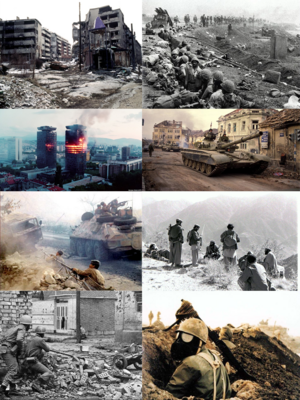Hisari Wars: Difference between revisions
The ©rusader (talk | contribs) (Rommie edited things in the infobox: Prov Gov added, casualties and strength edited, Prov Gov flags everywhere, some leaders changed to correct ones) |
The ©rusader (talk | contribs) (Bullets added {{*}}) |
||
| Line 124: | Line 124: | ||
| casualties1 = {{flag|Hisaristan}}<br>'''Military dead'''<br>100,000-400,000<br>'''Military wounded'''<br>400,000-1,000,000<br>'''Military missing'''<br>75,000-100,000<br>'''Total'''<br>575,000-1,500,000 KIA, WIA or MIA | | casualties1 = {{flag|Hisaristan}}<br>'''Military dead'''<br>100,000-400,000<br>'''Military wounded'''<br>400,000-1,000,000<br>'''Military missing'''<br>75,000-100,000<br>'''Total'''<br>575,000-1,500,000 KIA, WIA or MIA | ||
| casualties2 = {{flag|People's Republic of Romellea}}<small> (1973-78)</small><br>'''Casualties and losses'''<br>36,975 soldiers dead<br> 67,322 wounded<br> 3,278 missing<br>58 tanks<br>24 combat aircraft<br>3 patrol ships<br>158 other vehicles<br>'''Total'''<br>107,575 KIA, WIA, or MIA<br>{{flag|Provisional Government of Romellea}}<small> (1979)</small><br>'''Casualties and losses'''<br>1,893 soldiers dead<br> 5,733 wounded<br> 57 missing<br>12 tanks<br>1 combat aircraft<br>34 other vehicles<br>'''Total'''<br>7,683 KIA, WIA, or MIA<br>{{flag|Fahran}}<br>'''Military dead'''<br>200,000-400,000<br> '''Military wounded'''<br>200,000-1,200,000<br> '''Military missing'''<br>75,000-125,000<br> '''Total'''<br>475,000-1,725,000 KIA, WIA, or MIA | | casualties2 = {{flag|People's Republic of Romellea}}<small> (1973-78)</small><br>'''Casualties and losses'''<br>{{*}} 36,975 soldiers dead<br>{{*}} 67,322 wounded<br>{{*}} 3,278 missing<br>{{*}} 58 tanks<br>{{*}} 24 combat aircraft<br>{{*}} 3 patrol ships<br>{{*}} 158 other vehicles<br>'''Total'''<br>107,575 KIA, WIA, or MIA<br>{{flag|Provisional Government of Romellea}}<small> (1979)</small><br>'''Casualties and losses'''<br>{{*}} 1,893 soldiers dead<br>{{*}} 5,733 wounded<br>{{*}} 57 missing<br>{{*}} 12 tanks<br>{{*}} 1 combat aircraft<br>{{*}} 34 other vehicles<br>'''Total'''<br>7,683 KIA, WIA, or MIA<br>{{flag|Fahran}}<br>'''Military dead'''<br>200,000-400,000<br> '''Military wounded'''<br>200,000-1,200,000<br> '''Military missing'''<br>75,000-125,000<br> '''Total'''<br>475,000-1,725,000 KIA, WIA, or MIA | ||
| notes = | | notes = | ||
Revision as of 15:04, 21 May 2019
This article is incomplete because it is pending further input from participants, or it is a work-in-progress by one author. Please comment on this article's talk page to share your input, comments and questions. Note: To contribute to this article, you may need to seek help from the author(s) of this page. |
| Hisari Wars | |||||||
|---|---|---|---|---|---|---|---|
 Clockwise from the top: Veliky Belgorod after its recapture by the Imperial Army, Romellenic forces fighting near Branishte; Salamat after a Romellenic bombing campaign; Hisari tank driving through Melnichar after its capture by the Imperial Army, a Hisari ambush of a Fahrani convoy in Haydaristan, Shurawi mujahideen in as-Sourh, Hisari soldiers hiding in the rubble during the Battle of Qazdamir, Fahrani soldier wearing a gas mask. | |||||||
| |||||||
| Belligerents | |||||||
|
Haydari Mujahideen (1976-81) Ramazani Mujahideen (1976-81) Shurawi Mujahideen (1976-81) Template:Country data Leidense Republic (1976-81) Supported by: Template:Country data Leidense Republic (1973-76) |
(1973-78) Grand Duchy of Veliky Belgorod (1973-78) (1978-81) | ||||||
| Commanders and leaders | |||||||
|
Hisari Leaders
Leidense Leaders |
Romellenic and Belgorodski Leaders
Simeon Kanizhanski Grand Knyaz of Veliky Belgorod | ||||||
| Strength | |||||||
|
Hisaristan At the onset of the warAfter Fahran declares war in 1978 1981 |
People's Republic of Romellea At the onset of the war1979 Fahran Fahran declares war in 19781981 | ||||||
| Casualties and losses | |||||||
|
Military dead 100,000-400,000 Military wounded 400,000-1,000,000 Military missing 75,000-100,000 Total 575,000-1,500,000 KIA, WIA or MIA |
Casualties and losses • 36,975 soldiers dead • 67,322 wounded • 3,278 missing • 58 tanks • 24 combat aircraft • 3 patrol ships • 158 other vehicles Total 107,575 KIA, WIA, or MIA Casualties and losses • 1,893 soldiers dead • 5,733 wounded • 57 missing • 12 tanks • 1 combat aircraft • 34 other vehicles Total 7,683 KIA, WIA, or MIA Military dead 200,000-400,000 Military wounded 200,000-1,200,000 Military missing 75,000-125,000 Total 475,000-1,725,000 KIA, WIA, or MIA | ||||||
The Hisari Wars were three separate but related armed conflicts: the Hisari-Romellean War (1973-1978) between Hisaristan (supported by Leiden and Dayganistan) and the Socialist Republic of Veliky Belgorod (supported by the People's Republic of Romellea, Veleaz, and the Aeian Socialist Union); the Hisari-Fahrani War (1978-1981) between Hisaristan (supported by Leiden, Dayganistan, and Synnia) and Fahran; and the Second Hisari-Romellean War (1979)) between Hisaristan and Romellea. The wars collectively lasted from 25 August 1973 when Veliky Belgorod declared its independence from Hisaristan to 14 May 1981 when Fahran and Hisaristan signed the Treaty of Sulh.
Hisari-Romellean War
Background
On 10 October 1973 Emperor Khasar declared that he would integrate Hisaristan's various vassal states during the Great Kurultai of 1973. Though the many vassal states of Mikhailoslav and Sarmatistan had largely acted independently of the Hisari Khaans for much of Hisaristan's history, successive rounds of legal, administrative, and military reform aimed at modernizing the Hisari government throughout the 19th and 20th centuries had drastically reduced their autonomy as the Hisari state became increasingly centralized. On 24 October, Khasar announced the implementation of the Khanmaydon Decree which formalized the full integration of Hisaristan's vassal states with a six-month transition period.
Responses to the Khanmaydon Decree were mixed. Liberal reformists and moderate nationalists who supported the devolution of state power to regions such as Mikhailoslav and Rumeliston that did not have a Dehghani majority argued that the Decree would further marginalize religious and cultural minorities and that it was anti-democratic as it was not put to a vote through the Greater Kurultai. Slaviansk separatist groups, many of whom were supported by and sympathetic to the Aeian Socialist Union, were particularly opposed to the decree, as many of them saw it as a precursor to a Dehghani colonization of Mikhailoslav. Irsadist groups were generally supportive of the Decree, though many prominent clerics criticized it for maintaining state-sponsored Alydian Orthodox institutions in Slaviansk vilayets. Dehghanis, Hazarakhanis, and Sükhbaataryn were overwhelmingly in favor of the Decree.
Vocal opposition among Slaviansk regions that were already under government control were generally muted. The reaction in many of the vassal states. however, was outrage as mass demonstrations erupted in cities such as Veliky Belgorod, Valdikhazar, Voskresensk, Novokuznetsk, and Voronezh.